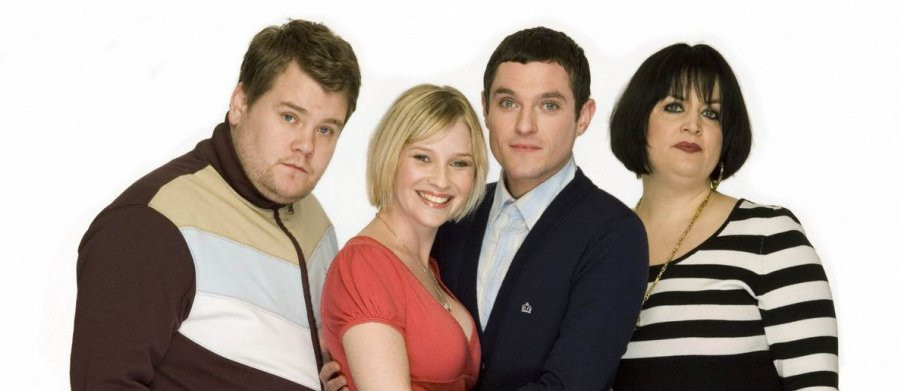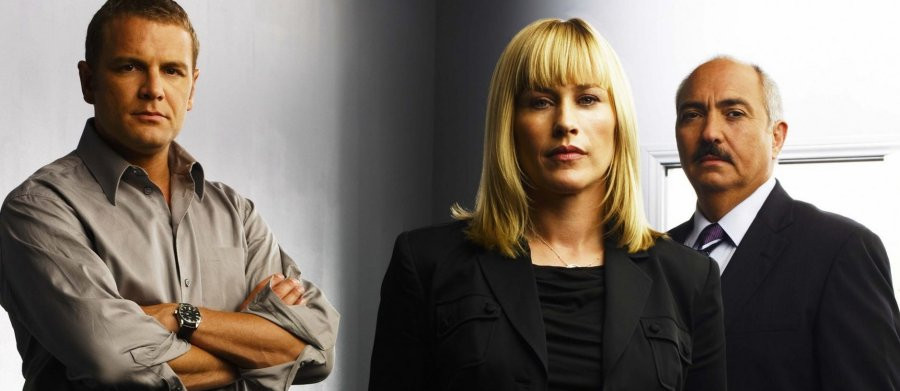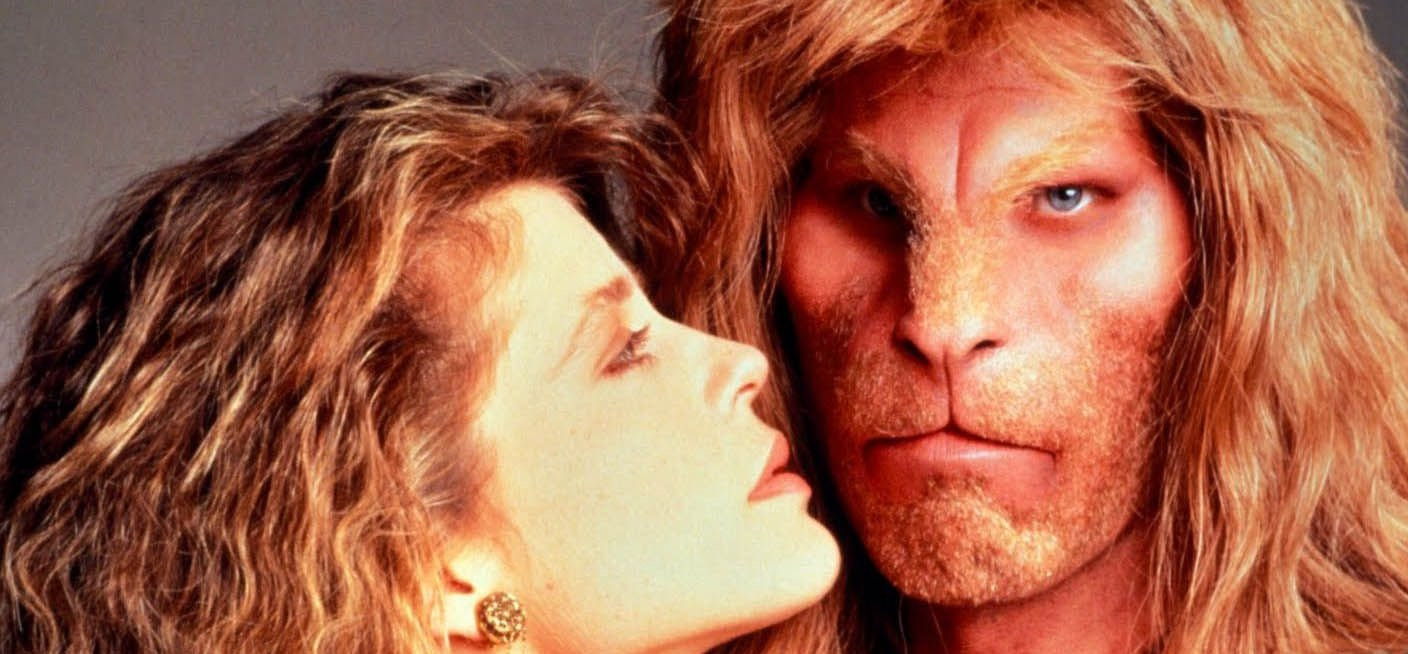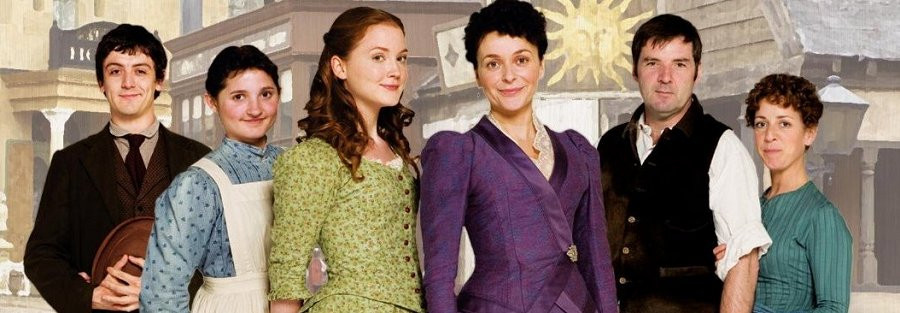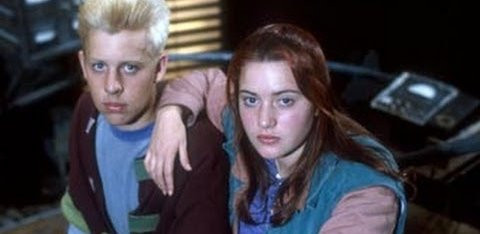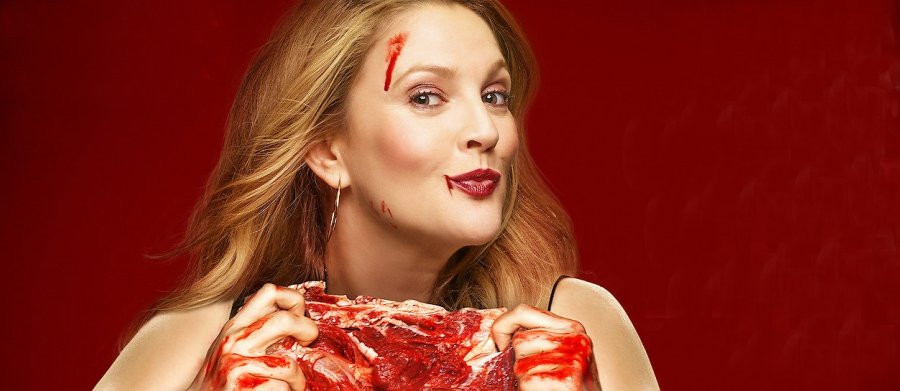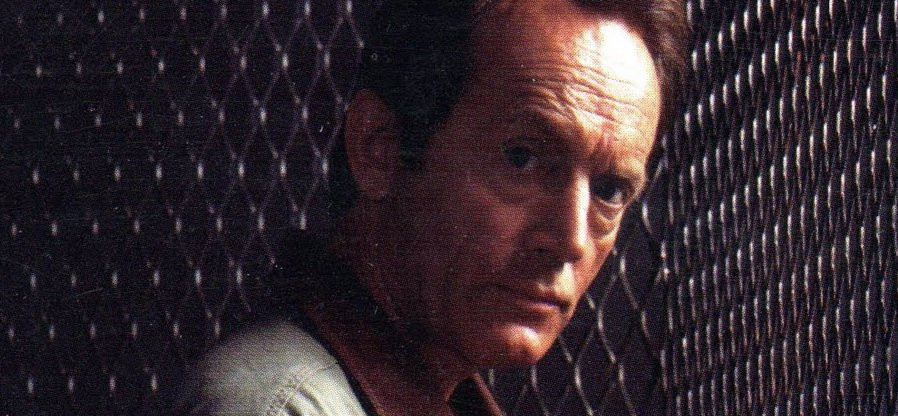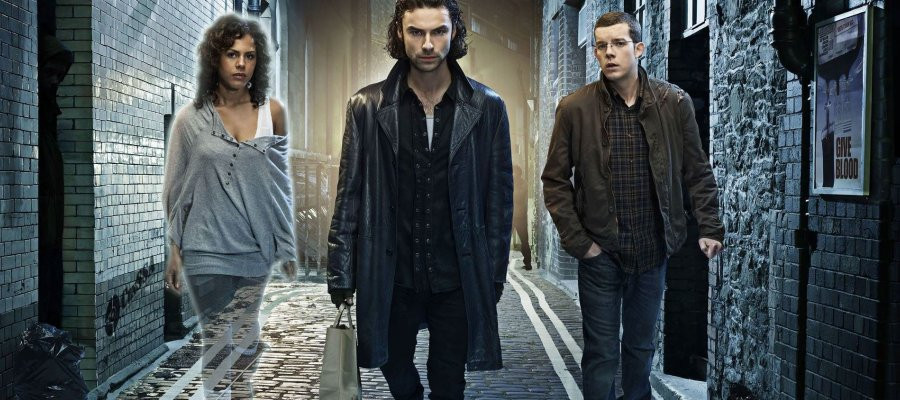
Being Human
2008 - United KingdomReview - Daniel Tessier
Oddly enough, the first concept for the show that was to become Being Human featured no supernatural elements at all. When approached by Touchpaper Television to create a houseshare drama, Toby Whithouse was unenthused, but nonetheless came up with three characters – George, Mitchell, and Annie – whose personalities and problems were compelling enough to warrant the production company’s continued interest. In took time, however, before the vital missing element of the show as agreed upon, and the Trinity of supernatural characters was born.
The use of the supernatural as metaphor for real, everyday problems was certainly not original to Being Human. Perhaps the most notable series to use this approach in recent years was Buffy the Vampire Slayer, in which vampires and demons and the threats they created reflected the ordinary yet vital issues the teenage characters were facing. The approach goes back far further, however; the most famous of vampire novels, Bram Stoker’s Dracula, presenting the vampire’s lust for blood as an explicit metaphor for sexuality. In creating his trio of paranormal protagonists, however, Whithouse married each preternatural condition with a recognisable and relevant problem. Being Human unites vampire, werewolf and ghost, representing addiction, infection and depression.
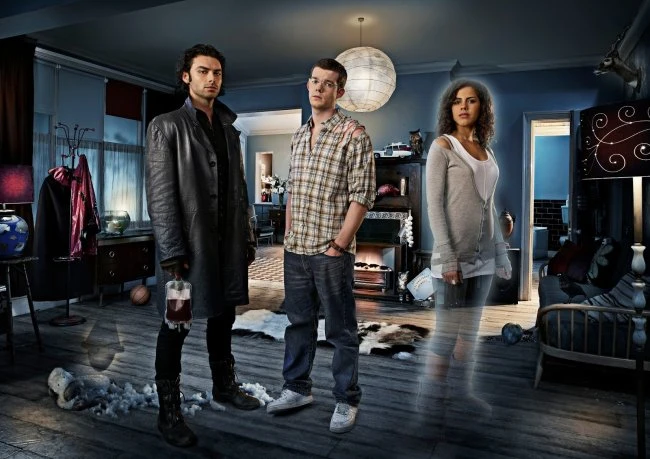
It is unlikely that any supernatural beings are more overrepresented in fiction than these three (although zombies are currently making a play for it). Being Human steered clear of clichés for the most part, and frequently poked fun at those it did entertain. Each of the ‘Types,’ as the series’ terminology would have it, had distinct attributes, that were revealed as the course of the series developed. Type Ones, the ghosts, exist forever frozen as they died, wearing the clothes that they died in, unable to move on to the next world due to something unfinished tying them to the material world. Usually unseen by the living, they are visible to other supernatural beings, and have such abilities as ‘Rent-a-Ghost-ing’ between locations (tongue-in-cheek pop cultural references being a staple of the series).
Type Twos, the vampires work as a predominantly villainous faction, arrogant and cruel, only a very few of their kind able to overcome their bloodthirsty nature. They are not harmed by sunlight, but are restricted by certain limitations, such as the inability to enter a home without invitation. Type Threes, the werewolves, on the other hand, are perhaps the most tragic of the three Types, cursed to turn into ravenous beasts at the full moon, looked down upon by vampires and treated like animals, their numbers kept down by vampire-organised ‘dog fights.’ In later seasons, these three central Types were joined by three more. The third season episode ‘Type Four’ introduced the far rarer living dead, while a fifth category, succubi and incubi, was introduced in season four’s ‘Hold the Front Page.’ These beings are the offspring of a human and a demon – by inference a sixth Type. It is said that the three main Types, and perhaps all supernatural beings, were created by the Devil.
As much as the series’ mythology grew during its five seasons, at its heart it was about the characters. Annie, George and Mitchell were there from the beginning, although not quite as we came to knew them. Being Human began with a pilot episode, produced for a season of pilots on BBC3 in 2008. Six pilots were filmed by different production teams, and at the end of the season, the BBC elected to continue one of these to continue into a full series. They chose Phoo Action, feeling that this comic-styled action adventure had the most potential as a series. For the viewers, however, Being Human was the clear favourite, and an online petition was started by Narin Bahar of the Reading Chronicle. I signed it, as did three thousand others, and the BBC followed popular demand. Phoo Action was dropped due to script problems, and Being Human was given the chance to go to series.
Series often end up rather different to their pilot episodes, and Being Human is a perfect example. The pilot, watched now, has a clear way to go before becoming the much-loved series. George, Annie and Mitchell were all present, but only George was played by the actor who would come to be associated with the role, Russell Tovey. Mitchell was played by Guy Flanagan, and Annie by Andrea Riseborough. Flanagan’s version of the vampire Mitchell, a self-consciously cool pale young man in dark clothing, matches the more gothic feel of the pilot episode, while Riseborough provided a more girl-next-door character for Annie than her successor, albeit one that was more blatantly neurotic. Once the series was confirmed, the direction of the series was rethought, with all but two actors – Tovey as George and Dylan Brown as the minor character of Seth – recast. As if Andrea Riseborough and Guy Flanagan weren’t beautiful enough, they were replaced by the stunning Lenora Crichlow, and Aiden Turner, a man so handsome he can make fingerless gloves look sexy. Thus the series was led by three rising stars, all of whom have gone on to greater things in still rocketing careers.
The first season followed on from events in the pilot episode, with the vampire, werewolf and ghost now living together as unlikely housemates in Bristol. Storylines begun in the pilot continued through into the first season, despite the change in cast, and there was an overall change in aesthetic, taking the series away from the deliberate spookiness of the pilot and in subtler territory. Mitchell had decided he was ‘on the wagon,’ his dependence on blood being a clear parallel with drug or alcohol addiction. All the while he had to keep secret his last immoral act a secret from his friends, having bitten his co-worker Lauren (Annabel Scholey, replacing Dominique McElligott), and transformed her, or ‘recruited,’ as the vampires have it. George, having severed all ties to his former, pre-infection life, struggled to juggle his human and wolf existences. His denial of his lupine counterpart, however, leads to his mismanagement of his condition, and simply separating himself from the wolf is not an option. In spite of his best attempts to remain apart from people, he falls for Nina, a nurse (played by Sinead Keenan). Both George and Mitchell took up menial jobs in their local hospital, the best way to keep a low profile, in spite of the alternatives on offer; George being highly intelligent and a gifted linguist, while Mitchell having a respected place in the vampire society.
While the two men struggled with their problems and developed their strong friendship, Annie dealt with more complex issues. While the nature of ghosthood drew parallels with depression, it was far more layered than that, with Annie passing through different stages of grief at her own death. While it was explicitly stated that ghosts are trapped in their final state, that did not preclude the possibility of character development, and Annie developed more than anyone else in the series. At first nervous of company and frightened of the outside world, her friendship with George and Mitchell brought her out of herself, allowing her to confront what was holding her to this world. Finally, she allowed herself to remember the cause of her death – murder at the hands of her boyfriend Owen. What could have been melodramatic was played with conviction and became a powerful examination of the many cases in which women stay with abusive partners, Annie having blocked out her treatment by Owen rather than facing it. Having finally found the strength to confront him, she was able to move on – only to make the decision not to in order to aid her friends in the first season’s final episode.
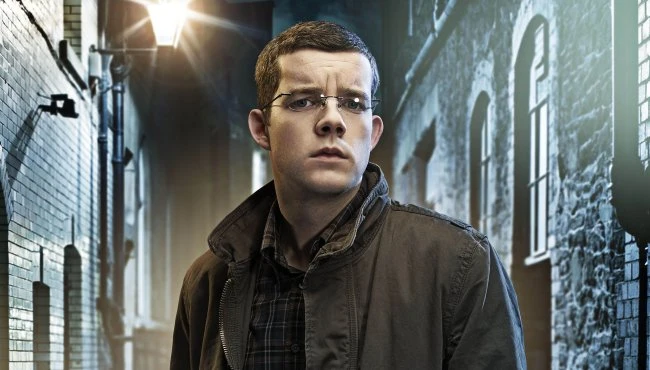
One of the great triumphs of this improved version of Being Human was its juggling of the ongoing lives of its main characters and the supernatural world that existed in the shadows all around them. While the three housemates did their best to live as normal and human lives as they possibly could, a vampire takeover was brewing in the background. The Bristol vampires were led by Herrick, undoubtedly the greatest beneficiary of the change in style between pilot and series. Played in the pilot by Adrian Lester as a handsome, charismatic leader, Herrick’s character was entirely rethought for the more grounded version of the programme that followed. In the first season, Jason Watkins portrayed the vampire leader, now a polite, unassuming individual who lived day-to-day as a police officer, but was behind the scenes a sort of vampiric middle manager. This interpretation of the role was far more successful, giving Herrick an insidious ability to blend into the working of the everyday world, something that only made it easier for him to progress his plans for a vampire insurrection.
Herrick and Mitchell had an interesting relationship, the former having recruited the latter during the First World War, and having taken him on as a sort of protégé. Pitting them at odds led to an inevitable showdown in the final episode of the first season (the first two seasons had no onscreen episode titles, but this has become known as ‘Bad Moon Rising’). However, it was George who eventually confronted him, taking the responsibility of his murder away from Mitchell. George arranged for the vampire leader to be locked in with him in his bunker, twisting his place of refuge into a place where the wolf would at last be free to kill. Herrick was torn apart, and the relationship between all three central characters had to change.
A recurring trick the series Whithouse used throughout the series was to close each season with a hint of the threat that would dominate the next. The first season ended with Annie’s now traumatised murderer Owen revealing his newfound knowledge of the supernatural to a mysterious individual played by Donald Sumpter. This character, Kemp, became the major villain of the second season. Played with his customary gravitas, Sumpter’s character began as a seemingly benign researcher into the supernatural world, later being revealed as a religious zealot dedicated to wiping out all inhuman beings. His insistence that vampires and the like were incapable of a human existence provided an unsettling commentary to the unravelling lives of the three housemates. Mitchell was left as nominal leader of the Bristolian vampires, and his attempts to use his postion to get others of his kind off human blood was inevitably doomed to failure.
George had even greater trauma to deal with, as Nina revealed to him that he had infected her with the werewolf taint. Having throughout the first season being viewed as a disease, the lycanthropy now became a metaphor for HIV in particular, with George now struggling with the guilt of passing it to the woman he loved. Having two werewolves in the house also altered the balance of the series somewhat, with Nina’s search for a cure leading her into the hands of Kemp, and George into the life of another woman. In some of the most upsetting scenes of the series, George’s desperate attempts to subdue the wolf within him and live an ordinary life with a real family lead to his complete collapse, the aggression of the wolf bleeding into his normally compassionate and reserved character.
To begin with, it appeared that Annie’s lot had improved dramatically for the second season. Her moving on from the circumstances of her death granted her far greater confidence, allowing her not only greater control of her supernatural abilities but also a more physical presence in the real world. What appeared to be a triumph for a character overcoming her psychological problems became instead a warning against moving too fast, as the spirit world pulled her back and away from the human life she was attempting to create for herself. Season two was about the failures of our heroes to fully integrate themselves with the ordinary world, and as such ended on a distressing note. With Mitchell betrayed by his new lover, Professor Jagget (Lynsay Marshall), revealed as an accomplice of Kemp, he fell into the arms of the dangerous vampiress Daisy (Amy Manson). Falling catastrophically off the wagon, he and Daisy perpetrated as vicious killing spree that would become known as the Box Tunnel Twenty Massacre, bringing into doubt whether he could ever truly be redeemed. Annie is, in a terrifying scene, exorcised by Kemp, returning only briefly to drag him to the next world, preventing him from destroying her friends. With their world in disarray and Annie seemingly lost, it seemed as if things couldn’t get worse Mitchell, George and Nina. The viewer, however, knew otherwise.
The third season saw the series relocated to Barry in Wales, a logistical decision to allow filming in Cardiff, along with many more of the BBC’s modern drama series. this allowed a fresh start for the characters, but this was of course a false hope, as events from the previous seasons would have major consequences in this one. There was also a great deal of development for the future, with new characters introduced who would go on to be major players in the series. As well as eternally adolescent vampire Adam (played with practised annoyingness by Craig Roberts), later for the short-lived online spin-off Becoming Human, we were introduced to McNair and his son Tom. These two vampire-hunting werewolves would shape the direction of the series from then on out. McNair was brought to life by Robson Green, the mums’ favourite giving him a hard, grubby character that shielded a compassionate heart, while young Tom had the sorrowful eyes of Michael Socha. His development into an adult having taken an unusual route, Tom was heartbreakingly naïve in many ways, yet remained a formidable fighter, something that the increasingly action-oriented series required.
The after-effects of the Box Tunnel Massacre ran throughout the third season. Mitchell’s rescue of Annie and their blossoming romance were tainted by his knowledge of what he was capable of, while George’s acceptance of his friend in spite of his crimes threatened to break them apart. The whole fraught situation put great strain on his relationship with Nina, who, against all odds, was now carrying their child. Alongside their personal dramas, the hostility between vampires and werewolves was growing. Herrick returned, having been resurrected by Daisy and fellow vampire Cara – vampires only truly being killed if they have been staked through the heart. The traumatised Herrick’s presence proved the catalyst for events to spiral out of control, while Lia (Lacey Turner), the ghostly victim of Mitchell’s killing spree, put her own plans into action. The third season ended with bloodshed, with Herrick finally done for good, McNair dead and even Mitchell staked by George. This heart-rending final scene was the only answer to Mitchell’s deteriorating character (and Aiden Turner’s burgeoning movie career), especially as now the Old Ones were coming to take control of Britain’s vampire population.
With one of the central trio gone, it was perhaps inevitable that further changes were coming. Season four began with a much-altered set-up. Nina had given birth to a baby girl, later to be named Eve, but had been killed by vampires between seasons; sadly, Sinead Keenan was seemingly not available to reprise her role. While Tom had become fairly assimilated into the household, he was still very much an awkward new member. With George in emotional turmoil, it was up to Annie to take charge of the household, becoming a mother figure to Eve and proving her strength once and for all. The opening episode, ‘Eve of the War,’ ended with George giving his life for his daughter in a truly devastating scene.
The collapse of our familiar band of characters could have spelled the end for the series. It’s never easy to replace a well-liked cast of characters. However, Being Human managed admirably, overcoming the potential silliness of creating a whole new supernatural trio by introducing the concept of the Trinity, the idea that somehow the vampire, werewolf and ghost family was in some way necessary to keep the supernatural world in its correct place. To that end, viewers were introduced to a whole new supernatural household, formed from the elderly werewolf Leo (Louis Mahoney), beautiful ghost Pearl (Tamla Kari) and 500-year-old vampire Hal (Damien Moloney). This group had been together since the 1950s, cementing the idea that the supernatural Trinity was somehow a part of the order of things. Drawn to Barry Island by the miraculous existence of Eve, Leo died, his old body unable to withstand further transformations, with Pearl passing over along with him. This left Hal as the new vampire of the group.
While Hal could be seen in some ways to be a straightforward replacement for Mitchell, Whithouse and Moloney created a distinct character. Unlike the savvy and confident Mitchell, Hal was socially awkward and revelled in routine; his obsession with sorting, counting and other minutiae being not only a way to control his vampiric tendencies, but perhaps also a parallel with autistic-spectrum behaviour, as well as an overdue recognition of such an aspect found in traditional vampire folklore. Moloney brought a genuine edginess to the part, the feeling that there was something dangerous lurking just below the surface. While Mitchell seemed to still revel in his coolness and vampire status, Hal truly seemed disgusted with himself. The only weakness in the character was an Angel-like tendency to display a distinct ‘evil twin’ personality when he fell from grace.
The fourth season displayed an increasing tendency towards the mythic. With Eve, the child of two werewolves, prophecised by the vampires as one who would bring the world to war, a more overtly fantastical element was brought into the series. The Old Ones, powerful and ancient vampire elders to whom Hal once swore allegiance, brought a more old-fashioned sensibility to the vampires, although they steered clear of the gothic aesthetic of the pilot episode. Mr Snow, played by the multi-talented Mark Gatiss, provided the series with its first real monster of a villain, a three thousand-year-old vampire with rotten teeth and pallid flesh. Along with this, we had Eve’s presence. While the events beyond the door to the other side had revealed that time had little meaning in the spirit world, here we had a grown woman (played by Gina Bramhill) killing herself in order to step back in time to her own infancy and change the course of history. The dystopian future, ruled over by the vampires with Hal as their commander lent a sci-fi air to the proceedings absent in previous seasons.
Annie’s presence throughout the fourth season gave a sense of continuity to previous years, easing viewers into the major cast changes. It was well known, however, that Lenora Crichlow would also be bowing out at the end of the season. With a complex storyline that involved the manipulation of both Tom and Hal by upwardly mobile vampire lawyer Cutler (the rather David Thewliss-like Andrew Gower), season four reached a shocking conclusion. This season also introduced Scots actress Kate Bracken as the tomboyish Alex, a potential love interest for Hal who ended up with her throat ripped out by Cutler. Her subsequent presence as a ghost left viewers in little doubt as to who would replace Annie as the Trinity’s resident phantom. The final instalment, ‘The War Child,’ set out to shock, with Hal going on a blood binge, Tom packing explosives in a suicidal plan to take out the Old Ones, and Cutler showing us the gruesome consequences for a vampire that forces his way into a home without invitation. It was Annie’s final act in this world that shocked viewers the most, though, as she detonated the explosives to kill not only the Old Ones, but the infant Eve at her future self’s pleading. There aren’t many shows out there that will actually go ahead and blow up a baby.
The fifth and final season gave us a much changed Being Human. The series was always going to have a fight on its hands when trying to win viewers back after killing off all of the much-loved original characters. While a little of the magic had gone, the final season still had tremendous appeal and great ambition. It’s only real crime was to try to do too much in its curtailed running time. Having introduced the mysterious Men in Grey, led by Steven Robertson as the mild-mannered Mr. Rook, in the closing moments of the fourth season, there was scope to build up a secret intelligence service dedicated to managing the supernatural population of the UK. However, season five went straight in with the closure of the department, leaving us to try to appreciate the effects of this on Rook before we had a chance to get to know him or his work.
Meanwhile, the vital nature of the Trinity began to become clear – not terribly clear, but it certainly had some role in maintaining the balance of the three key supernatural ‘races.’ Alex settled in nicely to the household, developing a strong friendship with Tom that worked well with his existing odd-couple bond with Hal. Hal, however, seemed doomed to live out his predecessor’s mistakes, not only recruiting a protégé – the nefarious Crumb, played by Colin Hoult – but struggling to stay on the blood-free wagon as Mitchell had done before him. With little time left, much of series’ mythology was laid open. The terrifying ‘men with sticks and rope,’ the spectral beings who guarded the other side of the door to the afterlife, made their first proper appearance after references going right back to the pilot. It was clear that major events were coming. It was, however, the unassuming figure of Captain Hatch – the spectacularly talented Phil Davies, doomed to forever play revolting characters – who became the focus for this season and the series’ climax. We learned of Hal’s role in the vampire-werewolf wars and his part in a summoning of the Devil himself, and his own cowardice in this affair being the reason that the great evil was now trapped in Hatch’s decrepit body.
The final ever episode of Being Human – aptly titled ‘The Last Broadcast’ – suffered somewhat from the same overstuffing as the season as a whole, but finally brought a truly world-shaking threat to the series. The flatshare drama of the original concept was now almost incidental, with these final moments embracing the series’ fantasy roots. With the Devil empowered by his pitting of the werewolf and vampire friends against one another, and now threatening all of humanity, he tempted the three members of the Trinity with their fondest desires to keep them from stopping him. They resisted, of course, and seemingly defeated the Devil’s plans, destroying his host body and banishing him for good. Or so it seemed... in a gloriously ambivalent ending, Whithouse left viewers questioning whether the final confrontation they had seen was real, or merely another illusion created by the Devil.
It is great pity that Being Human has ended, but in fairness, it’s hard to imagine how a sixth series would have proceeded. They had faced the Devil, after all – how do you top that? Nonetheless, Being Human's many fans will miss a series that took such seemingly disparate elements as a comedic homeshare drama and supernatural war and blended them together into an engaging, absorbing, intelligent, funny and sexy ongoing story. Whithouse and his co-writers, the central cast and the many memorable one-off guest stars, and the production team as a whole should remain proud of creating a truly unique take on a genre many thought was well-worn and used up. However, it may not be the very end of the story. Throughout its run, Being Human utilised the broader scale of modern television in a way few other series have managed, providing supplementary materials online and on commercial releases that added to and expanded the events and characters seen in the series proper. Indeed, a single extra scene set after the close of the series is set to be included on the final DVD release, perhaps answering the final fates of the Trinity more concretely. While any hope of a revival seems unlikely, it is always possible that Whithouse and his colleagues could think of a new direction for the series. Having built up such a backstory, there seems to be plenty more of the supernatural world to explore. You can only kill a vampire permanently by staking, after all. Mr. Snow was only blown up...
Seen this show? How do you rate it?
Seen this show? How do you rate it?
Published on November 29th, 2018. Written by Daniel Tessier (2013) for Television Heaven.


